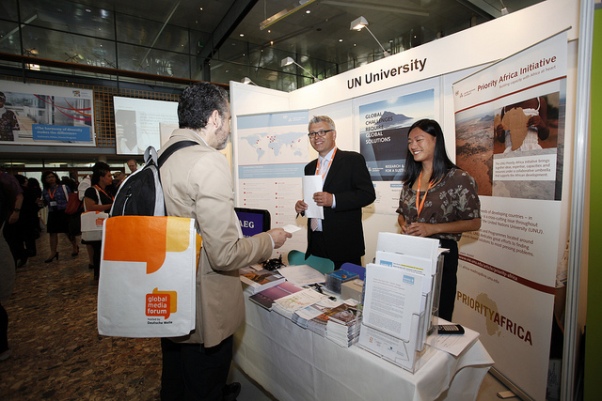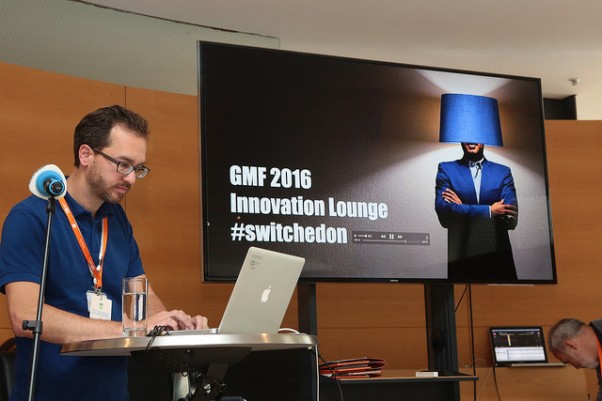Search Results for Tag: Big Data
Three innovations that are reshaping journalism
Artificial intelligence, data technology and mobile devices have huge potential in advancing the way journalists use and disseminate information. However, bringing innovation into newsrooms requires streamlined applications that journalists can easily use. With a wide network of partnerships and many big ideas, DW’s innovation team is working on an array of research projects to develop tools that will be changing how we produce and consume journalism. These projects were on display at the “Innovation Lounge” during the 2016 Global Media Forum, where guests could experience new tools and technologies hands on.
After looking at the research and development being done at DW Innovation, it becomes clear that journalists need solutions for using and interpreting large amounts of data and information coming from many sources, languages and formats. There is more information available than ever before and the key is turning information into interesting stories.
Natural Language Generation (NLG) technology, being pioneered by start-ups such as Narrative Science, turns data into readable reports. Applying this to journalism, DW’s innovation team is currently working on a new project called PollyVote, which for the first time is developing tools to transform polling data into automated news reports for the 2016 US presidential election. Research done by DW Innovation indicates audiences tend to respond positively to these automatic reports, citing a study that ranked them as informative, trustworthy and accurate.
Besides having raw data as useable information, journalists also have a huge variety of news sources at their disposal. At the intersection of big data, automation and multimedia production is News Stream, a joint project being developed by Fraunhofer IAIS, Neofonie GmbH, dpa and DW.
News Stream combines multimedia sources on one platform so journalists can quickly find exactly the information they need to create the best possible content. From pinpointing audio clips to digging quotes out of manuscripts, journalists can access all possible content on a news item in one place.
For example, News Stream uses voice recognition technology that can identify the subjects voice in a recorded press conference and send an automatic e-mail to the journalist with the desired quote. It also allows for automated research covering social media, agency sources and other news outlets. Journalists can even monitor in real time how the competition is reporting on a news item in real time.
According to the team at DW Innovation, at the moment News Stream has the potential to help journalists create better content more efficiently, but the most important step still is integrating these tools into newsrooms.
Adding to the journalists’ innovation toolbox along with raw data aggregation and source integration are methods for working with social media and eyewitness media as a news source. Both present problems of verification, but are becoming indispensible for fast-breaking news stories.
Reveal is a EU-supported project focused on dealing with social media verification. Multiple partners, including DW Innovation, work on tools, methods and technologies that will support journalists with the verification of online news items.
As part of the project, DW Innovation has developed a verification checklist for DW and media partners like ARD and EBU that outlines the fundamentals of how to use eyewitness material in news reports. This helps journalists everywhere make better decisions about breaking news content and produce trustworthy reports. There is furthermore a growing niche verification industry with examples like First Draft News, which brings together a variety of verification resources, or Storyful, which curates viral content and provides verification of UGC and social content for news outlets.
In order to continue its work in this field, DW Innovation has secured funding from Google’s Digital News Initiative (DNI) to build a collaborative social media verification platform and to launch another EU co-funded project called inVid,which specifically develops tools and workflows for video verification.
As the public comes to expect better data journalism and different ways to experience news, these types of innovations that are pioneered at DW will be growing in relevance and presence across our media landscape.
Using mobile technology in creative ways
 Digital and mobile technology is changing the world but some effects may be less obvious than what you see every day. A selection of talks and presentations from niche companies to big telecoms will cover some innovative trends and techniques at the 2014 Global Media Forum.
Digital and mobile technology is changing the world but some effects may be less obvious than what you see every day. A selection of talks and presentations from niche companies to big telecoms will cover some innovative trends and techniques at the 2014 Global Media Forum.
A presentation hosted by big-data experts, Flowminder, and the United Nations University – Institute for Environment and Human Security (UNU-EHS), focuses on how collecting and analyzing mobile data can be used in determining the extent and real effects of mass displacement following major environmental catastrophes. The presentation titled Big data, big insights: Mapping climate-induced displacement with mobile data, takes a unique look at how mobile data can be used to get accurate assessments of where people go, if they return and if proper aid is being provided to affected areas. The group will present the results of data analysis from five million anonymous cell phone users in the wake of Cyclone Mahasen that struck Bangladesh in May 2013.
Also exploring the effects of mobile technology on society and social development is a discussion hosted by the Vodafone Institute for Society and Communication titled, M-powering society: How mobile technology is changing society. The panel will discuss how mobile technology is being applied to create mobile health, mobile education and mobile government, emphasizing what makes mobile solutions more effective and the positive impact of mobile technology in developing areas of the world.
A talk hosted by the Grimme Institut will cover how digital technology is changing the way people express themselves and share narratives. The session titled See YOU in the future – new ways of digital storytelling, looks at how digital technology has given everyone a voice and has broken down social and cultural barriers. The discussion will explore future tools and platforms and introduce how digital stories are used in different areas of society.
In the final installment next week before the Global Media Forum begins, we will highlight some events covering the main issue at the conference – how digital technology is enabling increased participation in media and governance.





Feedback